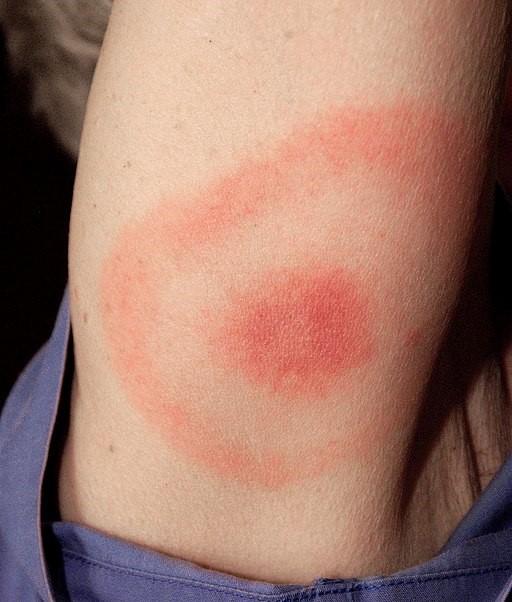
Tick bites: how to recognise and treat
Peer reviewed by Dr Colin Tidy, MRCGPLast updated by Lawrence HigginsLast updated 31 Jul 2025
Meets Patient’s editorial guidelines
- DownloadDownload
- Share
- Language
- Discussion
The UK Health Security Agency (UKHSA) is warning people to protect themselves against tick bites this summer, as the latest figures shows that there were 1,581 confirmed cases of Lyme disease reported in 2024. The warning coincides with music superstar Justin Timberlake revealing he has been diagnosed with the sometimes debilitating disease.
Here we look at what happens if you get bitten by a tick and what to do about it.
In this article:
Spending time in nature is great for your health. However, when enjoying the great outdoors, walking in woodlands or strolling through grassy areas can come with certain pitfalls - such as ticks.
The common tick, often found in fields or woods, are tiny eight-legged creatures which survive by attaching themselves to your skin and feeding off your blood.
Tick numbers are on the rise, and while only a few are harmful to human health, it's important to be aware of these disease-carrying pests, how to remove them from your body, and how to treat their bites.
Continue reading below
What does a tick look like?
To the naked eye, a tick may be almost undetectable when first attached to your skin. Over a period of time - up to around 36 hours - the tick will gradually become bloated from consuming blood and will be easier to notice.
Ticks burrow into the skin of their host, meaning that if one has attached, you may only see part of their body - which swells as blood is consumed. A bulging tick may look like a black or brown bean against the skin.
How to remove a tick
It's important to remove ticks carefully to prevent the spread of infection. As the visible end of a tick may be bloated with blood and bacteria, you should avoid squashing the body when removing the tick as this may cause the release of harmful bacteria into your bloodstream.
Special tick removal tools are available from pharmacies. These grip the underside of the tick and help removal without putting pressure on the body of the tick. Tweezers can be used, but only if you're careful.
Dr Thuva Amuthan is a skin specialist based in Birmingham, UK. He says that if a tick becomes attached to you, you should use a tweezer or removal tool to grasp the tick as close to the skin as possible.
He warns: "Be careful not to crush the tick. Slowly pull upwards to remove and dispose of it as soon as possible. Clean the bite and apply antiseptic."
Continue reading below
How can I tell if I've been bitten?
Ticks will usually drop from the skin when they're full, often without you noticing. So, it's important to be aware of the tell-tale signs of a tick-bite. If ticks attach, then drop from your skin unnoticed, they will often leave a mark behind. This may look like a red patch, bruise, or rash.
"Tick bites usually aren't painful, although you may get some itching," says Amuthan. "The tell-tale sign of a tick bite is the bulls-eye rash - a rash that is red at the centre, with an extra ring of red skin around it, which may grow bigger over time. A tick bite might also look like a bruise on darker skin. Some people get flu-like symptoms as a result of a tick bite."
Bulls eye rash

Do you always get Lyme disease from a tick bite?
While having a tick bite may feel alarming, only a few of ticks in the UK carry the bacterium that causes Lyme disease. Other infectious diseases transmitted to humans from ticks include tick-borne encephalitis (TBE), which is quite common in some parts of Europe, and Crimean Congo haemorrhagic fever (CCHF).
Even if you are bitten by a tick carrying infectious bacteria, the chances of falling ill from a tick bite are low if the tick was not attached for a long period of time - around 36 hours. A tick that has not attached or can be easily removed from the skin is extremely unlikely to have passed on any harmful infection. However, do speak to your doctor if you are worried.
Continue reading below
Where are ticks most common?
Ticks carrying Lyme disease bacteria might be found anywhere in the UK. However, according to Amuthan, the most common areas for Lyme disease infection are currently grass and woodlands in the south and north of England as well as the Scottish Highlands. While this shouldn't put you off taking a stroll in these areas, you should always check for ticks afterwards as a precaution.
Ticks can be picked up at any time of year. However, their population swells during the months between March and June, and again in August to November in the UK, so take extra precautions during these times.
How can I protect myself?
Simple measures can reduce your chances of being bitten by a tick. Use an insect repellent and cover up your skin, especially on the lower half of your body. Wear trousers rather than shorts and tuck the end of your trouser legs into your socks to lower the odds of a tick attaching to your skin. After walking through a wooded or grassy area check yourself, your pet, and your children for ticks.
How to treat a tick bite
While your chance of developing Lyme disease is small, if you have been bitten by a tick or develop a rash, it's important to seek medical treatment.
If a doctor thinks you might have a tick bite and sees the bull's eye rash, they will often offer antibiotics. These can treat Lyme disease and prevent further complications. Sometimes, a blood test will be offered - especially if the bull's eye rash is not present - although due to the delay before results, antibiotics are often prescribed as a precaution until results are known.
Amuthan says:
"Lyme disease is best treated early. See your doctor if you have been bitten by a tick and develop a round rash or flu-like symptoms - such as fever, aches, tiredness, or headache."
Keep calm and carry on
The health benefits of walking, exploring nature, spending time outdoors or breathing fresh air outweigh the small chance of being bitten by an infectious tick. However, knowing how to recognise, treat and protect yourself is important. Understanding how to tackle the issue if it happens means you can go back to enjoying the great outdoors without worrying too much.
Patient picks for Stings and bites

Infections
Lyme disease
Lyme disease is an infection caused by being bitten by an infected tick. The first and most common symptom is a rash that spreads out from the site of the tick bite. Left untreated, the germs (bacteria) can spread to other areas of the body. In some cases this can cause serious symptoms - often months after the initial tick bite. A course of antibiotic medication will usually clear the infection.
by Dr Philippa Vincent, MRCGP

Skin, nail and hair health
When should I worry about an insect bite?
Insect bites are common at this time of year - but what are the signs that a bite may require medical attention, and how can you tell which insect is responsible for which itch?
by Heather Ainsworth
Continue reading below
Article history
The information on this page is peer reviewed by qualified clinicians.
Next review due: 31 Jul 2028
31 Jul 2025 | Latest version
24 Oct 2022 | Originally published
Authored by:
Gillian Harvey

Ask, share, connect.
Browse discussions, ask questions, and share experiences across hundreds of health topics.

Feeling unwell?
Assess your symptoms online for free
Sign up to the Patient newsletter
Your weekly dose of clear, trustworthy health advice - written to help you feel informed, confident and in control.
By subscribing you accept our Privacy Policy. You can unsubscribe at any time. We never sell your data.